But the exercise of moving the data brought up the constant problem of data migration, that is, moving data from older file formats to newer ones before the old data is lost through obsolescence. In some cases, this comes about as a result of using an older version of a currently supported program, but in many cases, the program is no longer available or may only be available in downloadable "free" versions online. Another concern is the lack of a common transfer method to recapture all of the information in the older program in a usable format.
I recently wrote about the online program called GenSoftReviews.com. In a passing remark, I wrote about the fact that many of the programs that were being reviewed are current unavailable or unsupported. We are currently facing another round of major software revisions with new computer processors coming our this year, 2015, and the concomitant upgrades to operating systems that follow. Here is a good outline of the way computer chips are evolving. See "Fifty Years of MicroprocessorTechnology Advancements:1965 to 2015." See also, "Intel’s PC Chief Sees Big Changes Coming in 2015."
GenSoftReviews.com lists 886 genealogy products as of the date of this post. I decided not to look at every single product, but only to select a representative sample of programs that are characterized as "unsupported." Fortunately, Louis Kessler, the programmer for GenSoftReviews.com has a search category for that label. A search on the "unsupported" category reveals about 39 programs. Of these unsupported programs, four of them have reviews in 2015. An additional eight programs had software reviews in 2014. Here are a few of the more prominently known programs on the list with ratings in 2014 and 2015:
- Mundia
- Family Tree Maker - up to version 16
- The Master Genealogist (TMG)
- Ultimate Family Tree (UFT)
- Personal Ancestral File (PAF)
- Generations
If people are still rating a program, it is still being used. In the case of Personal Ancestral File, for example, the program is listed as last updated in 2005. It is also important to note that some of these programs receive five star ratings, higher than many of the currently most popular programs.
These facts point out the limitations of software reviews, but more importantly indicate that there are still people out there in the genealogical community who are seriously at risk of losing all their data if it is locked up in one of these programs. This list also ignores the fact that even older versions of currently supported programs may have file formats that are unsupported today. For example, if you are using older floppy disk based versions of Personal Ancestral File, these versions are very difficult to recover because the data in in multiple files and may be on more than one floppy disk.
The particular program I was facing when I started my current data recovery project which involved re-entering all the data from the original paper documents, involved a "currently supported" program but an older version of the program where the current program could no longer read the data files.
This area of concern also includes genealogy programs that were released on one computer format, such as the old Apple version of Personal Ancestral File, and are no longer supported in that version. I listed the unsupported programs above because they had current reviews, but what about all the data on unsupported programs that have no reviews. I am further very aware of this problem because I switched back to using only Apple computers and I have been moving my data to different programs for a long time now.
Is there a solution to this problem? There is likely no overall solution and genealogical data will be somewhat constantly lost over time. If you are reading this post, it is likely that you do not have this problem, simply by virtue of the fact that you are online and aware of the problem. But, if you know someone who professes to be interested in genealogy and has their data locked up in some discontinued program, you might try to convince them to move their data to some more supported format as soon as possible, at least, before the next round of new computer processors comes out later this year.













